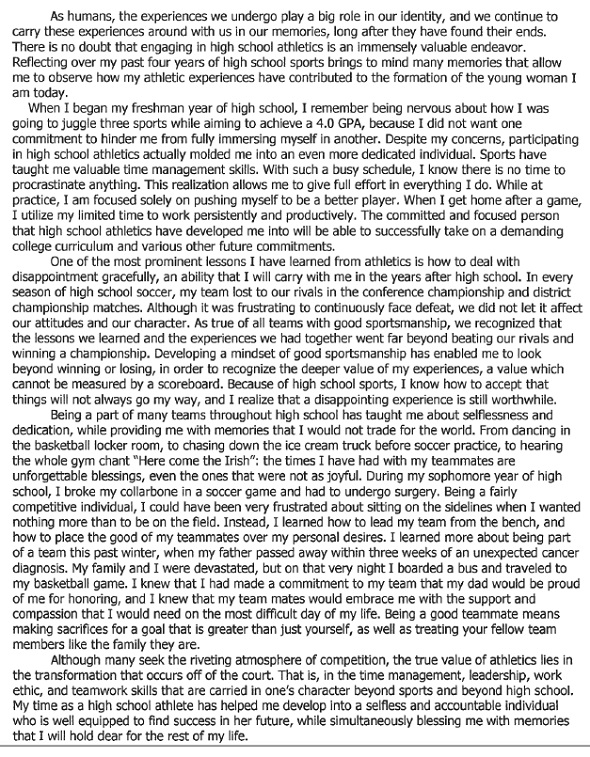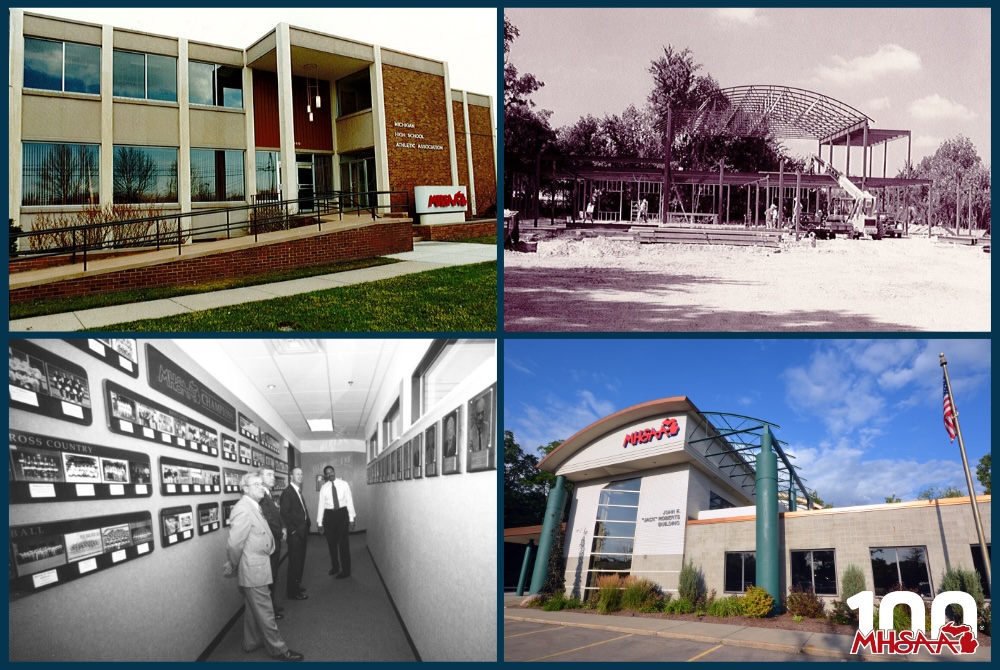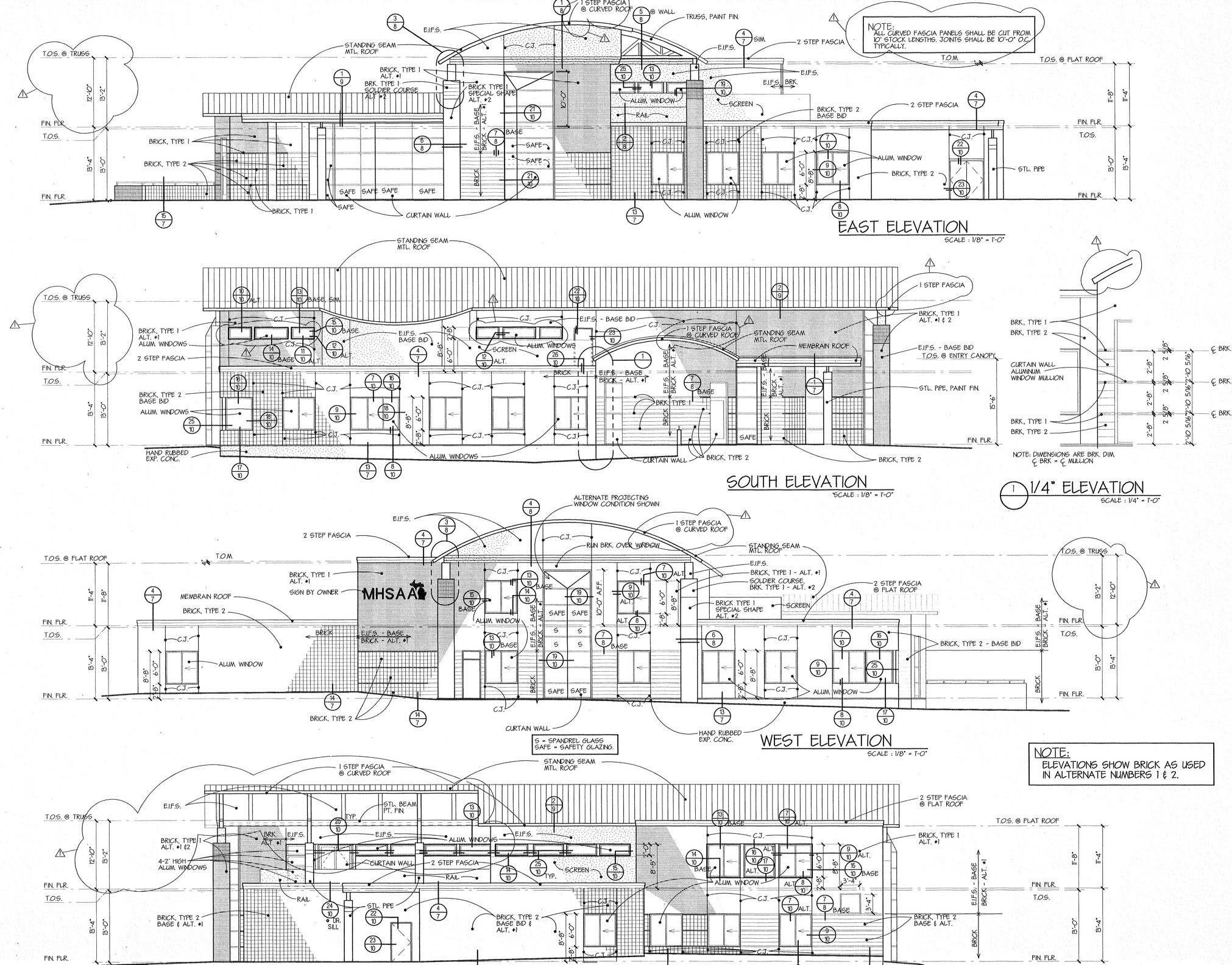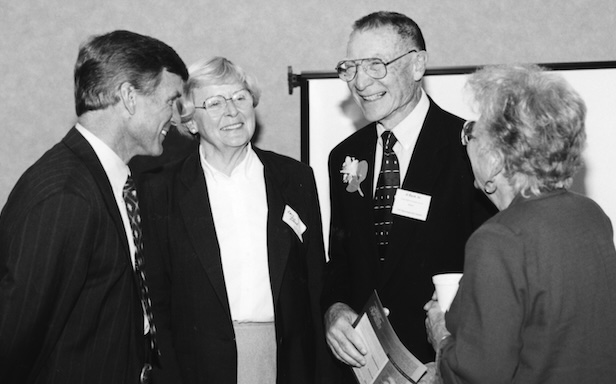
Recent Stars Build on HS Sports Foundation
By
Pam Shebest
Special for MHSAA.com
January 23, 2018
Mattawan’s Allie Havers experienced high school sports in part as a stepping stone to a scholarship and eventual national championship at the University of Nebraska.
 Hackett Catholic Prep’s Hope Baldwin earned two national awards and several scholarships for an essay on the role of high school sports in shaping her future.
Hackett Catholic Prep’s Hope Baldwin earned two national awards and several scholarships for an essay on the role of high school sports in shaping her future.
But for both Kalamazoo-area athletes, high school sports had a much deeper impact than just national recognition.
Baldwin, who is not playing varsity sports as a freshman at University of Notre Dame, was an MHSAA Scholar-Athlete Award winner, received the National Interscholastic Athletic Administrators Association National Scholar Athlete of the Year award in Phoenix in December and will travel to Atlanta in April for the Coach Wooden Citizenship Trophy.
She wrote the essay while a senior at Hackett and, looking back, she said, “When I wrote that essay, I think it was probably March of my senior year. Now, being in college and not being involved in those athletics any more has given me the opportunity to appreciate them even more.
 “Reading my speech and being able to look back on how I was writing from that perspective still in high school, I was like, ‘Oh my gosh.’ I knew it was important then, but now not having it any more I realize even more what a benefit high school sports are.”
“Reading my speech and being able to look back on how I was writing from that perspective still in high school, I was like, ‘Oh my gosh.’ I knew it was important then, but now not having it any more I realize even more what a benefit high school sports are.”
The lasting impression for both athletes is not a specific game or highlight, but “mostly I miss my teammates and coaches,” Baldwin said.
“In each season, coming in every day to practice with the same people really made unique bonds because we were all working toward the same goals.”
Havers, who was first-team all-state in three sports at Mattawan, said looking back, it’s the people who made the deepest impression.
“I remember the people, the coaches, my teammates and the seniors who were on the team my senior year,” she said. “I look back, and it was a pretty cool experience. I’m really humbled.
“I didn’t do it by myself. I had help from my parents, siblings, coaches and teammates.”
Words of wisdom
Baldwin was stunned when her essay won for the state of Michigan and then for her NIAAA section (Michigan, Wisconsin, Iowa, Illinois, Indiana).
She then was chosen as the female national award winner, earning a $2,500 scholarship in addition to a plaque.
Among points she emphasized were the following:
- “Sports have taught me valuable time management skills.”
- “I learned … how to deal with disappointment gracefully, an ability I will carry with me in the years after high school.”
- “Developing a mindset of good sportsmanship has enabled me to look beyond winning or losing. … I realize a disappointing experience is still worthwhile.”
- “I broke my collarbone in a soccer game and had to undergo surgery. … I learned how to lead my team from the bench.”
She added that although most enjoy the thrill of competition, “the true value of athletics lies in the transformation off the court. That is, in the time management, leadership, work ethic and teamwork skills that are carried in one’s character beyond sports and beyond high school.”
Baldwin, who is majoring in neuroscience and behavior with a pre-med concentration, said she chose Notre Dame for academics rather than attending a smaller school where she might have played sports.
While she played four years of volleyball, basketball and soccer at Hackett, that drive for competition has not completely left her.
“I’ve been doing some intramural sports, which is really fun,” she said. “Sand volleyball, basketball and our dorm had a flag football team. We actually ended up making it to the championship and we got to play in the Notre Dame football stadium, so that was really cool.”
Succeeding, switching, succeeding again
Havers had no doubt she would be playing college sports after an outstanding career in basketball, volleyball and softball at Mattawan, graduating in 2013.
She earned a basketball scholarship to University of Michigan but when the coach left, she de-committed and eventually ended up with the Cornhuskers.
 The transition from high school to college hoops was an eye-opener.
The transition from high school to college hoops was an eye-opener.
“I had to catch up to the game,” Havers said. “In college, the girls are a lot bigger, a lot stronger, a lot faster and more physical. I knew the girls at post, my position, were a lot stronger than me.
“I came in at (6-foot-4) 140 pounds, and most others in the post position were 180 to 200 pounds.”
Her practice schedule was also different.
In high school, the team practiced about two hours a day.
But in college, “We practice four hours and on the court just about every day,” Havers said. “You have school work, lifting, meetings, tutors. You will definitely come out with great organization skills.”
After playing four years of basketball at Nebraska and graduating with a degree in psychology, Havers knew she did not want to give up competition in a college atmosphere.
“I had a fifth year of eligibility left but not in basketball, so I went out for the volleyball team,” said Havers, who is working toward a master’s degree in journalism and mass communications. “I knew if I didn’t try, I would regret it. Nebraska is a volleyball dynasty.”
She was faced with a situation unfamiliar to her.
“I played every basketball game, but I played just two volleyball games,” she said. “It was a lot different. I was used to playing a lot in basketball and all through high school, too.”
“No athlete likes sitting the bench, but you learn your role and you go with it. I feel really blessed for the opportunity and knew I had to work hard for a spot.”
The payoff was the NCAA National Championship when Nebraska defeated Florida in the four-set final Dec. 16.
Even though her college eligibility is gone, Havers, who hopes coach once she graduates, is still playing sports at the intramural level.
“Beach volleyball is a college sport at Nebraska,” she said. “It’s a three-month season with an indoor court.”
Havers' advice for high school athletes is: “Go in with an open mind, go in with heart and leave nothing on the table. Go to practice earlier and stay later.
“Coaches promise you anything, but that’s not always the way it goes. You have to go with the flow.”
 Pam Shebest served as a sportswriter at the Kalamazoo Gazette from 1985-2009 after 11 years part-time with the Gazette while teaching French and English at White Pigeon High School. She can be reached at [email protected] with story ideas for Calhoun, Kalamazoo and Van Buren counties.
Pam Shebest served as a sportswriter at the Kalamazoo Gazette from 1985-2009 after 11 years part-time with the Gazette while teaching French and English at White Pigeon High School. She can be reached at [email protected] with story ideas for Calhoun, Kalamazoo and Van Buren counties.
PHOTOS: (Top) Mattawan’s Allie Havers, left, and Kalamazoo Hackett’s Hope Baldwin enjoyed outstanding high school athletic careers. (Middle) Baldwin, top, and Havers. (Below) Havers went on to play both basketball and then volleyball at Nebraska. (Basketball photo courtesy of Nebraska’s athletic department; soccer photo courtesy of Hackett’s girls soccer program.)
ESSAY: See the full text of Baldwin’s essay below that contributed to her selection as an NIAAA Scholar Athlete winner for 2017.


Century of School Sports: MHSAA's Home Sweet Home
By
Rob Kaminski
MHSAA benchmarks editor
November 5, 2024
Visitors to 1661 Ramblewood Drive for the multitude of MHSAA committee meetings, in-services and other functions are sure to see the faces of Michigan’s renowned educational athletics leaders throughout the years on various recognition boards.
Absent from any of those displays is the late East Lansing resident Thomas Reck. Yet, Reck and the long-range vision of Jack Roberts were equally as vital in “restructuring” the MHSAA in the late 1990s; quite physically.
“I really wanted something along US-127 – visible from 127 – and there was a good deal of open land where the building sits now that looked to be about the right size,” recalled Roberts, who at the time was just finishing the first decade of what would be an iconic 32-year run as the executive director of the MHSAA.
There was one potential roadblock to Roberts’ dream location: There was no indication of any kind that the property was for sale; no billboard, no realty listing.
That’s because it wasn’t for sale – yet.
“I contacted a realtor, Martin Property Development, and I suggested one of their employees call upon Mr. Reck,” Roberts said. “He did that, and got a purchase price of $600,000. To me, the excitement really took place before the first shovel went into the ground.”
The deal was then approved by both parties, and development began in 1996, with Reck’s residence remaining in place atop the small hill south of the new road leading to the proposed site of the MHSAA building.
“When we bought the land, there was no road,” Roberts said. “One of the reasons it curves is that Mr. Reck was given a life lease, so we had to go around his house. It also had to navigate some protected wetland areas.”
As for the name of the road, that was the MHSAA’s choice, one which actually came quite easily. The city of East Lansing had some concerns with the new development, and expanding on an existing name for the road was the first show of good faith by the newest tenants. Keeping the name Ramblewood made sense as there was already a Ramblewood Drive at the exact intersection to the east of Coolidge Road.
“We didn’t want to come in and change a lot of things, or inconvenience the residents in that area,” Roberts said. “We kept development back from the road and kept as much nature intact as possible. Even the signs that are there now are off the road and relatively small.”
Roberts and staff needed no signs to find their way to the new digs just more than three miles north of the previous offices on Trowbridge Road.
 Led by Roberts and former assistant director Tom Minter, much of the moving occurred during Christmas break of 1996. Doors to the new building were opened in January 1997, roughly seven years after Roberts first began dreaming of a new home.
Led by Roberts and former assistant director Tom Minter, much of the moving occurred during Christmas break of 1996. Doors to the new building were opened in January 1997, roughly seven years after Roberts first began dreaming of a new home.
The building on Trowbridge was formerly a credit union, and its structure provided some unique problems.
“In the late 1980s, around ‘88 or ‘89, we bought our first major computer, an IBM mainframe, and put it upstairs in the old building,” Roberts said. “It was about five feet high and eight feet wide and had its own room. We had to drill through concrete to wire it. I began to realize that we were going to have a hard time keeping up with things in a building that was so difficult to modernize.”
John Johnson, the MHSAA’s first communications director and a pioneer in that position among state high school associations, also reflected on the early days.
“Anything which was data-driven was jobbed out for awhile,” Johnson said. “Football playoff rankings were delivered to us once a week from a third party. We were doing everything outside the building: school databases, officials databases, penalty databases. The only thing we had inside the walls was word processing. I had the first PC in 1987.”
And, he recalled, the beast of a mainframe that took up an entire room at the expense of personnel. “Yep, it took up the whole room,” Johnson confirmed. “I was in what was called the library, which had historical books, but also old T-shirts left over from previous years’ champions.”
That lack of storage was also motivation for Roberts to find new real estate, and addressing that shortcoming was paramount in the plans.
“We had no storage, and no efficient way to receive shipments like rules books, paper, and the basic supplies we needed to run our business,” Roberts said. “That’s also why we have the lift in its current location at the new building; shipping and receiving were really important to us, along with our drop ceiling which made it much easier to run wiring as needed.”
As sparkling and expansive as the new facilities were, perhaps the best feature of all was its cost. The structure only took up a portion of the land purchased by the association, per Roberts’ vision. That left four parcels on the property for sale by the MHSAA, and with the road and utilities in place, those sections became even more valuable and enticing.
The MHSAA’s expenditures totaled roughly $1 million for the purchase of the land, road construction and utility installations. The parcels then sold for approximately $300,000 apiece.
“In the end, we had our space free of charge, and had $200,000 for furnishings,” Roberts said. The lone cost would then be the actual construction of the building, financed through a bond. And, the MHSAA could choose their neighbors, which was also part of the grand plan.
“We were going to be particular about who moved in, and that they’d be further back; not right on the road,” Roberts said. “Above all, we wanted to be good neighbors to the residents in the area and choose businesses that would be good neighbors as well.”
The other four parcels are occupied by medical practices, and the area remains a somewhat sleepy and hidden subdivision to this day.
Interestingly, and unknown to most, the MHSAA nearly held on to the parcel closest to its front door as a rental venture. That prospect led to spirited but friendly debate among Representative Council members at the time, leading to a vote on the matter of whether to sell the land or construct another building and rent space in that structure.
“There was good-natured discussion on the topic with arguments both in favor of selling and for building and renting on that last parcel,” Roberts said. “I remember on the morning of the vote, I offered the Council this to think about: We were really good at rules, really good at interpretations and administration of school sports. None of us were landlords or experts in that field.”
By a 10-9 vote, the Association would sell the final plot. “We didn’t get greedy, and history showed it was the right decision, what with the housing market landscape years later,” Roberts said. “We’d already won the lottery in a sense. Why enter into an area in which we knew little about?”
The timing of this new gem couldn’t have been any better, as the MHSAA was hosting the Section 4 meeting of state high school associations in September 1997. It was the perfect opportunity to showcase the facility with an open house attended by those in town for the meeting as well as current and former MHSAA staff and dignitaries.
Met with the now-recognizable and unique high-arching “roof” – half copper and half green, open frame – visitors were impressed. “The architect was on vacation in Florida and saw a similar building with the copper roof. When she assured me that it wouldn’t turn green over time, I agreed to do it,” Roberts said. “The design is actually still trendy, so it’s held up over time.”
Indeed it has, as verified by builders and designers currently giving the MHSAA’s home its first facelift.
“When I told people how old the building was, they couldn’t believe it, because its design has held up so well,” said MHSAA Assistant Director Dan Hutcheson, who has worked closely with contractors on building renovations during the last several months.
Even prior to this expansion and cosmetic overhaul, the MHSAA and its technology, staff were looking to the future.
 “Ironically, we upgraded projectors and cameras to delve into Zoom and virtual meetings before we really even knew what they were or how valuable they could be,” Hutcheson said. “This was winter of 2020, and a couple months later, Covid hits and by luck we’re kind of prepared, at least communication-wise.”
“Ironically, we upgraded projectors and cameras to delve into Zoom and virtual meetings before we really even knew what they were or how valuable they could be,” Hutcheson said. “This was winter of 2020, and a couple months later, Covid hits and by luck we’re kind of prepared, at least communication-wise.”
Following the Covid-19 pandemic, once the MHSAA was back on solid footing, Executive Director Mark Uyl began to outline and identify areas for expansion and updating inside the building.
Roberts’ foresight in the initial storage and expansion areas have paid huge dividends, as plenty of space existed for new offices.
The first meeting with architects post-pandemic was in September 2022, with renovations beginning in September 2023. Now, two years later, the project is near completion.
New color schemes, video boards, LCD displays and touchscreens serve to keep the facility in stride with those to which the MHSAA’s constituents have become accustomed.
There was plenty of work behind the scenes, too, such as fixtures and plumbing which simply had exceeded their lifespan or needed to be brought up to current codes. The overall mission for the changes, as always, was to better serve the membership.
“We serve 750 member schools, with so many from those schools coming here for training, teaching and educational sessions,” Hutcheson said. “As our staff members visit schools around the state, we see video boards, electronic message boards. We needed to keep in step with the schools, and in doing so, better assist our ADs, coaches and officials with their work.”
For two people who didn’t know one another, Reck and Roberts brought countless people together since 1997 to help them do their work.
Previous "Century of School Sports" Spotlights
Oct. 29: MHSAA Summits Draw Thousands to Promote Sportsmanship - Read
Oct. 23: Cross Country Finals Among MHSAA's Longest Running - Read
Oct. 15: State's Storytellers Share Fall Memories - Read
Oct. 8: Guided by 4 S's of Educational Athletics - Read
Sept. 25: Michigan Sends 10 to National Hall of Fame - Read
Sept. 25: MHSAA Record Books Filled with 1000s of Achievements - Read
Sept. 18: Why Does the MHSAA Have These Rules? - Read
Sept. 10: Special Medals, Patches to Commemorate Special Year - Read
Sept. 4: Fall to Finish with 50th Football Championships - Read
Aug. 28: Let the Celebration Begin - Read
PHOTOS (Top) Clockwise from top left: The former MHSAA office on Trowbridge Road. (2) Work is underway on the new MHSAA building on Ramblewood Drive. (3) The MHSAA office on Ramblewood before recent updates that included a switch from green to gray on the exterior. (4) Now-retired assistant director Nate Hampton, far right, and others walk the upstairs hallway of the recently-built Ramblewood building. (Middle) Blueprints for the Ramblewood office exterior. (Below) Past Executive Director Al Bush (right) and his wife, Lois, were on hand for the 1997 open house hosted by then-Executive Director Jack Roberts (left) and staff. (MHSAA file photos.)

